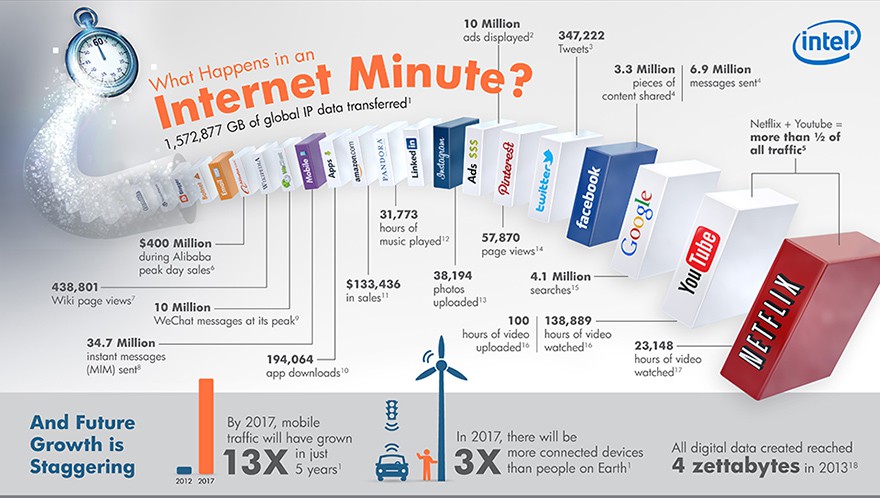Haldan Consulting was fortunate to attend a presentation by Karin Kruger from KPMG’s Data & Analytics department, entitled ‘FROM DATA to INSIGHT’
As an introduction, she highlighted what happened on the internet in a single minute (Intel 2014). These included:
- 1,573 million GB of data is transferred in 1 minute;
- $400 million of sales done, on a peak day for one website(Alibaba), in 1 minute
- 10 million Ad’s are displayed each minute;
- Netflix and YouTube combined, account for more than half of all traffic on the web. Users view 139, 000 hours of video on YouTube, and 23 thousand hours of video on Netflix, every minute;
- 10 million WeChat messages and 35 million other Instant messages are sent each minute; and
- In one minute only, 194 thousand apps are downloaded
These are staggering statistics. What’s more, she explained that by 2017, mobile traffic will have grown 13 times over a 5 year period and there will be 3 times more devises connected to the web than there are people on this planet.

(source of this information: infographic Intel's What Happens in an Internet Minute?)
Once this is contextualized, it’s no wonder that there is a new buzz about BIG DATA. KPMG states that one of the drivers for the adoption of data analytics is “technological advances enabling and fueling big data.”
The problem with this explosion of data from a business point of view is what to do with all of it. Big data is complex, large and unstructured. Tradition analytical methods are slow and cumbersome. Data Scientists have emerged and are helping Companies with rapid and agile insight delivery. Analytical tools are available at point of decision and become integral to running the business.
This move from “Data to Insight”, as Kruger calls it, is the next big challenge for business and typical inhibitors: Difficulties arise when developing a central data pool. There is a shortage of skills and a lack of a data driven culture and management support. And, budgetary constraints also need to be addressed.

(image sourced of KPMG presentation: "From Data to Insight" Sept 2014)
In a Data and Analytics survey, done by KPMG International, August 2013, some leading insights were that:
- 69% said Data & Analytics was critical or very important to the interviewees’ Growth plans.
- 42% consider integrating data technology into existing models a big challenge with data capturing
- 85% said finding a solution to analyze & interpret data is difficult.
- Respondents identified that knowing which data to collect a problem.
- 96% said they could do better at Data & Analytics
Kruger then illustrated how business was using Data &Analytics, providing interesting examples, like
- How a retailer (Target) knew a teenager was pregnant before her family, because of the purchases she made in their stores;
- An app that displays the location of girls, who have registered, and are in close proximity to a current location in real time;
- A car seat that recognizes your backside and sets up the drivers seating position; and
- How Ford were using Data & Analytics in manufacturing to provide real-time data to drivers of hybrid cars about engine misfires and other warnings. This allows vehicle performance to be automatically adjusted. They also were able to discover that lady drivers wanted a foot-activated-sensor that opens the rear door when your hands are full.
Other areas that have benefited from Data & Analytics are:
- Using data acquisition to find and process oil and gas
- Discovery Vitality Health monitors driver behavior and rewards good driving
- First National Bank leveraging data and its networks in apps to address Client needs, which resulted in client retention through rewards
- Square Kilometer Array (SKA): Generates 14 exabytes of data a day, which is collated and visualized in the form of images, so that data so it can be used by astronomers.
It is clear that the possibilities are endless when it comes to using big data.
HaldanMES contributes to big data in manufacturing, by giving companies access to real-time and historical data in a way that is clear and easy to interpret. It facilitates immediate corrective action by visualizing losses in the factory. By making this type of information available to everyone in the organization, detailed knowledge and informed understanding is spread from the top levels of the organization, down to the base or shop floor of the company.
Published October 2014, Written by Rob Ermes, Sales and Marketing Manager at Haldan Consulting